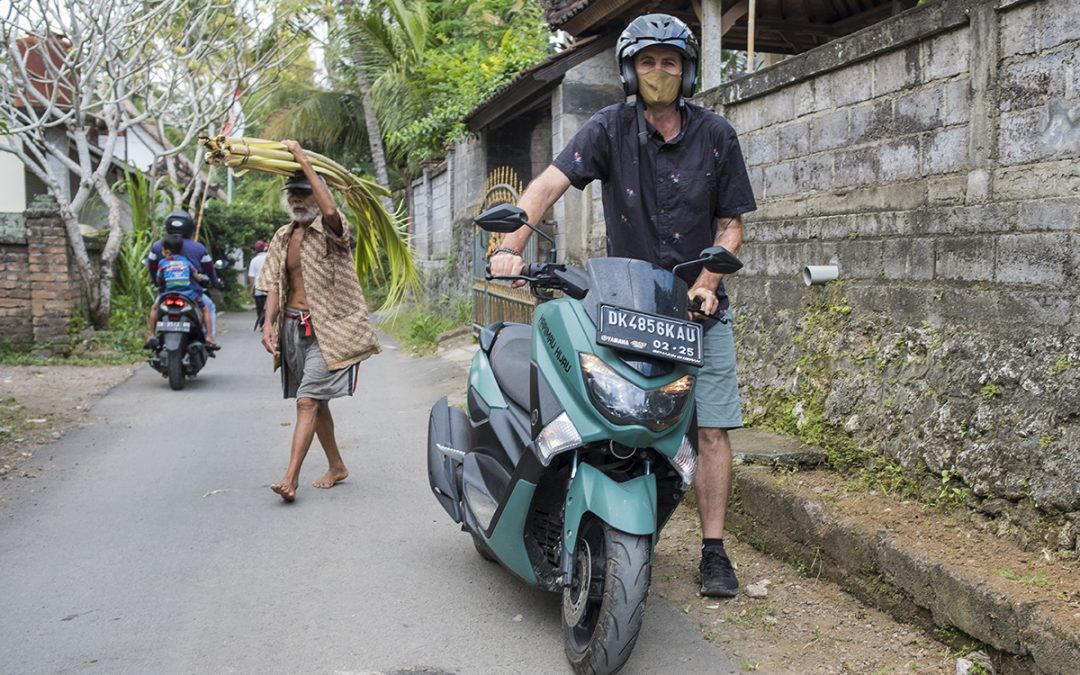Spoiler: this is not a mechanical guide to changing a motorbike tyre (if you need that, then Google it). With a car, as long as my jack, tools and tyre are ready, I’m like pit-lane. What I’m talking about here is a motorbike (or scooter) in Bali. Bikes in Bali don’t have tool-kits (unless you put one together yourself) or spare tyres.
It starts with a wobbly wheel, something is wrong – you hope it’s just your imagination, but the wobble gets worse (and even dangerous), so you pull over and, yep … it’s a flat tyre. Insert blog-inappropriate curses or count-to-10 mindfulness activity – important to release the tension. Lucky it’s not raining. But, then maybe it is raining. Well, at least it’s only flat on the bottom (sorry – that’s a ‘dad joke’).
The process of ‘How to Change a Motorbike Tyre’ is a life-skill check-list. STEP ONE: Think Critically – where is the nearest bengkel (mechanic)? Check the maps in your head, search your recent or long-term memory downloads. I got my biggest ‘thinking critical’ power-boost on a gaff-rigged schooner – I thought I could sail before stepping on Providence V. There was so much to learn by using only what I already knew to create a better understanding.
If you’ve got no idea, you’ll need to move to STEP TWO: Collaborate – ask someone: ‘Pak/Ibu, di mana bengkel?’ (you might need to add ‘paling dekat’ (the closest)). We are very rarely left to face a problem completely on our own – and when we are, it is often the skills we learned from others (in collaboration) that get us through. If your language skills fail you, Think Creatively – it shouldn’t be hard to get the message across with some hand-signals and pointing. I’ve had full conversations (over multiple nights) with Indians in tiny off-the-map Orissan villages with absolutely no spoken language.
STEP THREE: Adapt – start adapting your day’s schedule. This flat tyre changes everything. You’re going to be late, or you won’t get there at all. That’s cool – things change … and you’ll need to bend. In this fast changing world, our adaptability is key to the future we create. Being able to adapt is the foundation of resilience and it looks like we are going to need as much of that as possible. All day, every day, is one continuous upskilling opportunity in Adaptability.
STEP FOUR: Activate – you will need to push your bike. So, get active. Start Pushing! There’s no substitute for hard work. It’s normally hot and sweaty, you might have a hill or two to push down and up. You either get on with it and get sweaty – or you sit and wait to get on with it and get sweaty later. When I was redesigning warehouse and logistics systems, I had to constantly remind myself that a waterfall starts with a single drop of water. Nothing gets done without doing something. One of my Maths skills I taught (over and over again) was “Do Something”. If my students learned nothing else, they learned that. The tyre isn’t going to fix itself – and the bike isn’t going to push itself. So, get active and PUSH!
STEP FIVE: Be Aware of your personal fitness levels. Yes, it’s hot, yes it’s sweaty, yes nobody is stopping to help you (because there’s nothing anyone can do to help). Persist. There really is no point giving in. I’ve learned that the only thing stopping me from achieving something is my ability to just keep going – whether it’s finishing a complex piece of art, getting into Glastonbury Festival (without a ticket), digging a trench, or pushing the bike to a mechanic – having an understanding of who I am and what I hope to achieve helps me to just keep going.
Next time life throws a curve-ball at you, take a close look at ‘How’ you’re moving through the problem. Don’t be surprised that when you look through a ‘life-skills’ lens at it, you will see how the skills we learn and practice all the time provide the tools we need to solve new problems. As educators, we need to think about what our students really need to learn. I want the lessons in my classes to help students negotiate a business deal, restore a friendship, find a solution to a building problem, fix a boat, adapt a travel schedule, and even to change a tyre on a motorbike.

